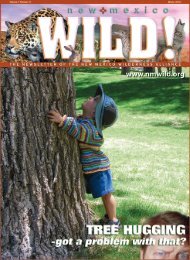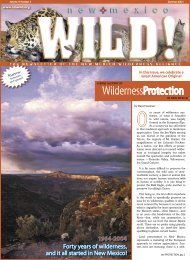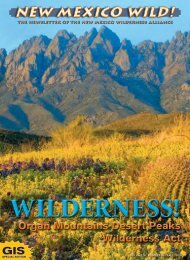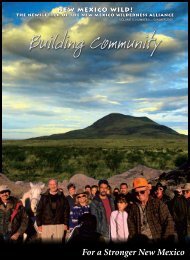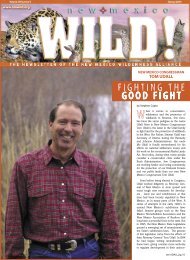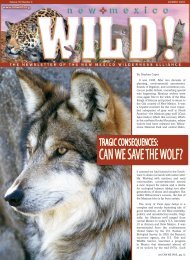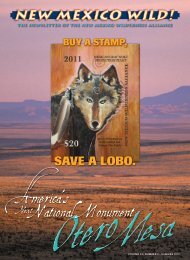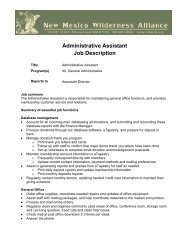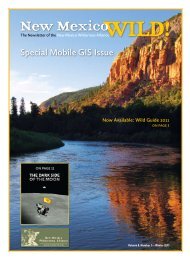here - New Mexico Wilderness Alliance
here - New Mexico Wilderness Alliance
here - New Mexico Wilderness Alliance
You also want an ePaper? Increase the reach of your titles
YUMPU automatically turns print PDFs into web optimized ePapers that Google loves.
Campaigns<br />
El Rio Grande del Norte proposed national monument<br />
The Rio Grande runs through this area, carving stunning cliffs through wildlands that host a lourishing<br />
population of plants and animals and archaeological sites dating back thousands of years. Additionally, this<br />
is home of the Rio Grande Migratory Flyway, which becomes home to thousands of migratory bird species<br />
in the winter months.<br />
Organ Mountains-Desert Peaks proposed national nonument<br />
The Organ Mountains-Desert Peaks National Monument proposal encompasses 600,000 acres of<br />
Chihuahuan desert grasslands, sky island peaks, seasonal streams, rare native cacti, dramatic canyons<br />
and historical artifacts on public land. Over the last six years, NM Wild has engaged diverse community<br />
support in a united effort to designate the Organ Mountains-Desert Peaks as a national monument.<br />
Historic treasures that would be protected include the Butterield Stagecoach Trail, the Apollo Space<br />
Mission training site at Kilbourne Hole, World War II aerial bombing targets, Apache Draw and its<br />
extensive archaeological resources, and the ecologically and culturally rich lands of the greater Sierra de<br />
las Uvas Mountains.<br />
Otero Mesa<br />
Otero Mesa is the largest and wildest grasslands left on public lands in America. We continue to work<br />
toward permanent protection for more than one million acres of wild grasslands in Otero Mesa. This<br />
important habitat must be preserved for its cultural resources as well as the aquifer that lies beneath it. In<br />
addition to nearly 1,000 plant and animal species, Otero Mesa holds special cultural signiicance through<br />
the petroglyphs and other ancient archaeological sites dating back more than 1,500 years.<br />
Columbine Hondo proposed wilderness<br />
This <strong>Wilderness</strong> Study Area is a beautiful example of the Sangre de Cristo Mountains in <strong>New</strong> <strong>Mexico</strong>, with<br />
high peaks, aspen forests, alpine meadows, and mountain streams. NM Wild is working with a coalition<br />
of local citizens including sportsmen, business owners and land grant members to protect more than<br />
43,000 acres as wilderness.<br />
Chaco Canyon proposed wilderness<br />
Located in northwestern <strong>New</strong> <strong>Mexico</strong> in a remote canyon, Chaco Culture National Historical Park preserves<br />
the most signiicant pre-Columbian ruins north of <strong>Mexico</strong>. The scale of Chaco’s architecture, the complexity<br />
of its community life, the high level of its community social organization and its far-reaching commerce<br />
created a cultural vision unlike any other seen before or since. Chaco is still considered sacred by virtually<br />
all of the Pueblo groups as well as the Navajo. Unbelievably, development and oil and gas drilling nearby<br />
continue to threaten this World Heritage Site, one of only eight cultural sites with this designation in the<br />
United States.<br />
Mexican Gray Wolf<br />
Through the Mexican Gray<br />
Wolves: Share The Land<br />
campaign, we strive to<br />
educate, motivate, and unite<br />
citizens around the fact that<br />
whole, intact ecosystems are<br />
necessary and desirable to<br />
existence. If we don’t share<br />
the land, we will destroy it.<br />
Gila National Monument<br />
The Greater Gila Ecoregion is home to one of the largest and most<br />
intact ecosystems in the Southwest. It is also home to the endangered<br />
Mexican gray wolf. At the heart of the region are the Gila and<br />
Aldo Leopold wilderness areas and the Blue Range, America’s last<br />
remaining primitive area. Together, these areas encompass more<br />
than one million acres. Surrounding the core wilderness areas of the<br />
Gila is an additional 1.5 million acres of wild public land currently<br />
unprotected and t<strong>here</strong>fore open to potential mining, logging, road<br />
building, and other extractive uses.



